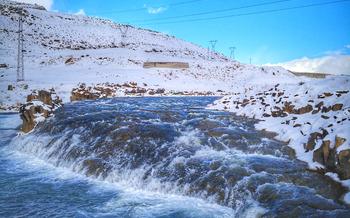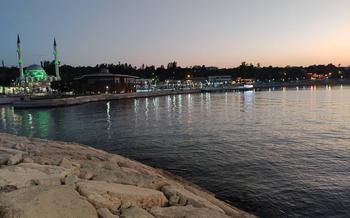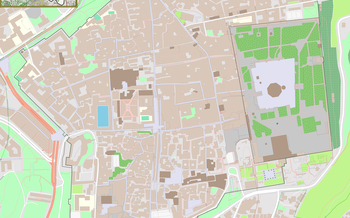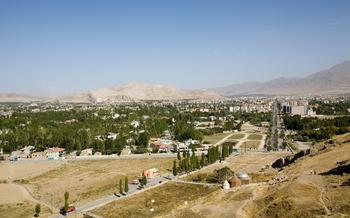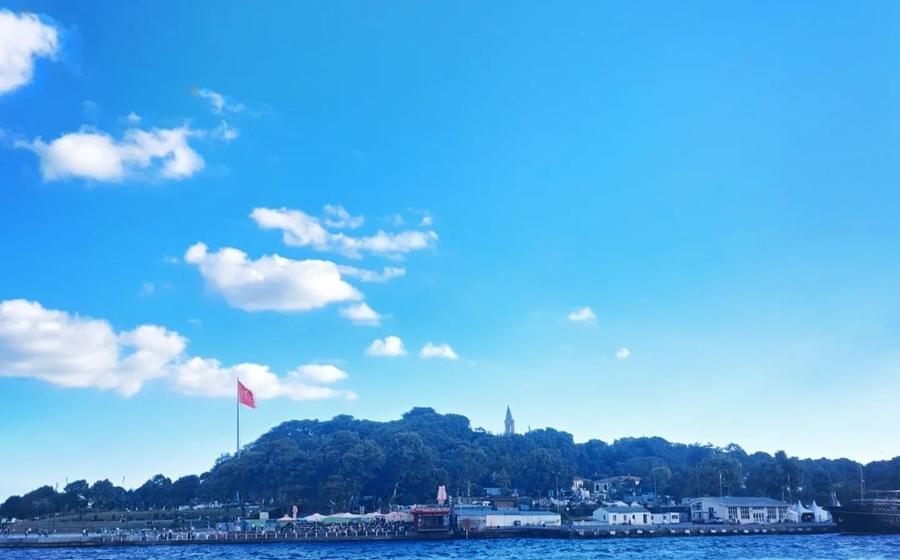
Girik Tepe
- Van's Ancient Wonder: Girik Tepe
- Unveiling the Past: Girik Tepe's History
- A Majestic Fortress: The Citadel
- Marvels of Ancient Engineering: The Water System
- Divine Expressions: The Temples of Girik Tepe
- Guardians of the Fortress: The Cyclopean Walls
- Realm of the Dead: The Necropolis
- Echoes of Rituals: The Sacred Spring
- The Lost City of Sardurihinili: A Neighboring Wonder
- A Tapestry of Cultures: The Museum of Van
- Local Cuisine: A Taste of Van
- Accommodations for Every Traveler
- Transportation Hub: Van's Ferit Melen Airport
- Insider Tip: Unveiling Hidden Treasures
Van's Ancient Wonder: Girik Tepe
Girik Tepe, an archaeological marvel nestled in the heart of Van, Turkey, stands as a testament to the region's rich history and cultural heritage. This ancient Urartian fortress, dating back to the 8th century BC, offers a glimpse into a civilization that once ruled over vast swathes of eastern Anatolia. Located just 12 kilometers from Van city center, Girik Tepe is easily accessible, inviting visitors to embark on a journey through time and uncover the secrets of this remarkable site.
Among the must-see highlights of Girik Tepe are the imposing citadel, a symbol of Urartian military might, and the intricate water system, a testament to their engineering prowess. The temples, with their remnants of ancient rituals, provide insights into Urartian religious beliefs, while the cyclopean walls showcase the kingdom's architectural mastery. Beyond the fortress walls, the necropolis reveals secrets of Urartian burial customs, and the sacred spring offers a glimpse into their spiritual practices.
Unveiling the Past: Girik Tepe's History
Girik Tepe's history is a captivating narrative of ancient civilizations, power struggles, and cultural influences. Its origins can be traced back to the Early Iron Age, around the 9th century BC, when the region was under the sway of the mighty Urartian Kingdom. The Urartians, known for their architectural prowess and military might, transformed Girik Tepe into a strategic stronghold and a vital gateway to the eastern frontiers of their empire.
Excavations conducted at the site have unearthed a wealth of artifacts, shedding light on Girik Tepe's rich past. Inscriptions, pottery, and other remnants of Urartian culture have helped archaeologists piece together the intricate tapestry of life within the fortress. These discoveries have revealed Girik Tepe's significance as a regional center, a hub for trade and commerce, and a crucial point of control for the Urartians. Its strategic location allowed them to monitor and regulate movement through the region, consolidating their power and influence over the surrounding territories.
A Majestic Fortress: The Citadel
Ascending to the summit of Girik Tepe, visitors are greeted by the imposing Citadel, a testament to Urartian architectural prowess. This fortified structure, perched atop the hill, served as the nerve center of the ancient city. Its massive walls, constructed from colossal stone blocks, exude an aura of strength and resilience. Within the Citadel's confines, visitors can explore the remains of palaces, temples, and other administrative buildings, each hinting at the grandeur and sophistication of Urartian civilization. A highlight of the Citadel is the Royal Palace, where the Urartian kings once resided. Its intricate carvings and well-preserved chambers offer a glimpse into the opulent lifestyle of the Urartian elite. From the Citadel's ramparts, visitors are rewarded with panoramic vistas of the surrounding landscape, encompassing the sparkling waters of Lake Van, the fertile plains, and the distant mountains, creating a breathtaking backdrop for this ancient fortress.
Marvels of Ancient Engineering: The Water System
Girik Tepe's water management system stands as a testament to the ingenuity and engineering prowess of the Urartians. A network of meticulously crafted channels, reservoirs, and aqueducts ensured a steady water supply for the inhabitants of the fortress and the surrounding settlement.
The channels, expertly carved into the steep slopes of the hill, collected rainwater and diverted it towards reservoirs strategically positioned throughout the site. These reservoirs, some of which are still visible today, served as storage facilities, ensuring a continuous water supply during dry periods.
The most remarkable feature of the water system is the aqueduct that transported water from distant springs to the fortress. This engineering marvel consisted of a series of underground tunnels and elevated channels that spanned several kilometers. The aqueduct not only supplied water for domestic use but also played a crucial role in irrigating the surrounding agricultural fields, transforming the arid landscape into a fertile and productive region.
The water system of Girik Tepe is not merely an ancient engineering feat but also a testament to the Urartians' deep understanding of hydrology and water management. Their ability to harness and distribute water effectively allowed them to thrive in a region characterized by a semi-arid climate and unpredictable rainfall.
Divine Expressions: The Temples of Girik Tepe
Amidst the ruins of Girik Tepe, the remnants of ancient temples stand as testaments to the religious beliefs and practices of the Urartians. These sacred spaces, once bustling with rituals and ceremonies, offer a glimpse into the spiritual world of this ancient civilization.
Though time has eroded their grandeur, the foundations and outlines of these temples reveal their significance. Scattered across the site, they vary in size and design, each serving a specific purpose in the Urartian religious pantheon.
The most prominent temple, located within the citadel, is believed to have been dedicated to the chief god, Haldi. Its imposing structure and elaborate decorations suggest its importance as a center of worship and devotion.
Other temples, dedicated to various deities, are found outside the citadel walls, catering to the spiritual needs of the broader community. These temples often incorporated altars, niches, and other features associated with Urartian religious practices.
Excavations at Girik Tepe have unearthed a wealth of artifacts related to religious rituals, including bronze statuettes of gods, votive objects, and inscribed tablets. These discoveries shed light on the beliefs and practices of the Urartians, revealing their reverence for the divine and the importance of religious ceremonies in their daily lives.
Exploring the temples of Girik Tepe is a journey into the spiritual realm of the Urartians, offering a glimpse into their beliefs, rituals, and the profound connection they felt with the divine.
Guardians of the Fortress: The Cyclopean Walls
The cyclopean walls of Girik Tepe stand as a testament to the ingenuity and engineering prowess of the Urartians. Constructed using massive stone blocks, these walls formed an impenetrable barrier around the fortress. The unique construction technique, involving the use of large, irregularly shaped stones fitted together without mortar, is a hallmark of Urartian architecture. These walls not only served as a defensive measure, protecting the fortress from invaders, but also symbolized the power and authority of the Urartian kingdom. Their imposing presence and sheer size continue to captivate visitors, offering a glimpse into the architectural achievements of this ancient civilization.
Realm of the Dead: The Necropolis
Outside the fortress walls of Girik Tepe lies a realm of profound significance—the necropolis, a city of the dead where the ancient Urartians laid their departed to rest. This sacred ground offers a glimpse into their intricate burial customs and funerary practices.
Among the intriguing discoveries within the necropolis are tombs of varying sizes, each holding secrets of the past. Some tombs are simple chambers carved into the rock, while others are more elaborate, featuring multiple rooms and intricate designs. Inside these chambers, archaeologists have unearthed a wealth of artifacts, including pottery, jewelry, and weapons, providing insights into the lives and beliefs of the Urartian people.
The necropolis also reveals the Urartians' unique approach to the afterlife. They believed in a realm beyond death, where the deceased would continue to exist in a spiritual form. To ensure a smooth transition, they buried their dead with objects they would need in the next life, such as food, clothing, and tools.
Exploring the necropolis is an awe-inspiring experience, allowing visitors to connect with the ancient Urartians and their reverence for the afterlife. It's a place where the echoes of the past whisper tales of mortality and the human spirit's eternal quest for transcendence.
Echoes of Rituals: The Sacred Spring
In the shadow of Girik Tepe's imposing presence, a sacred spring whispers tales of ancient rituals and spiritual beliefs. This enigmatic water source, located a short distance from the fortress, was once a focal point for Urartian religious practices. Water held a profound significance in their culture, symbolizing purity, fertility, and the connection to the divine.
As you approach the sacred spring, a sense of reverence fills the air. The water emerges from the earth, forming a tranquil pool that shimmers in the sunlight. Urartians believed that this water possessed mystical powers and used it for various rituals and ceremonies. They would gather here to make offerings to their gods, seeking blessings, guidance, and protection.
The spring's proximity to the fortress suggests that it played a vital role in the daily lives of the Urartian rulers and their subjects. Perhaps the royal family and priests performed sacred rites here, invoking the gods' favor for their kingdom's success and prosperity. The spring's waters may have also been used for purification ceremonies, cleansing both body and spirit before entering the sacred precincts of the fortress.
Today, the sacred spring stands as a testament to the deep spirituality of the Urartian people. Its serene atmosphere invites visitors to pause and reflect on the enduring power of faith and the mysteries of ancient rituals. As you listen to the gentle murmur of the water, let your imagination transport you back in time, to a world where gods and mortals intertwined, and nature's elements held profound significance.
The Lost City of Sardurihinili: A Neighboring Wonder
Just a short distance from Girik Tepe lies another captivating wonder of the Urartian civilization: the ancient city of Sardurihinili. Once a bustling capital during the reign of King Sarduri II, this city boasts a rich history and impressive ruins.
Founded in the 8th century BC, Sardurihinili served as a strategic center for the Urartians, controlling trade routes and defending their eastern borders. Its strategic location allowed the Urartians to monitor the movements of their rivals, the Assyrians, and to protect their empire from invasion.
While Sardurihinili may not be as well-known as Girik Tepe, it offers a fascinating glimpse into the grandeur of the Urartian civilization. Explore the ruins of its once-mighty fortress, admire the intricate rock carvings depicting scenes of battles and religious ceremonies, and marvel at the ingenuity of its water management system.
Comparing Sardurihinili to Girik Tepe reveals striking similarities and intriguing differences. Both cities showcase the Urartians' mastery of engineering, with impressive fortifications, water channels, and reservoirs. However, Sardurihinili's location on a plateau and its larger size suggest that it may have been a more important administrative and political center.
Unveiling the secrets of Sardurihinili is an adventure in itself. As you wander among the ruins, you'll feel a sense of wonder at the civilization that once thrived here. The city's rich history and strategic significance make it a must-visit destination for anyone interested in ancient civilizations and the captivating story of the Urartians.
A Tapestry of Cultures: The Museum of Van
In the heart of Van, the Museum of Van stands as a testament to the region's rich history and diverse cultural heritage. Within its walls, a treasure trove of artifacts from Girik Tepe and other Urartian sites awaits eager explorers. Step into a world where ancient civilizations come alive through intricately carved stone tablets, pottery adorned with vivid designs, and bronze sculptures that whisper tales of a bygone era. Discover the significance of Urartian culture as you trace its evolution from its humble beginnings to its rise as a powerful kingdom. Learn about their unique writing system, religious beliefs, and artistic expressions that continue to captivate scholars and historians alike. The museum's collection offers a comprehensive insight into the lives, customs, and achievements of this ancient civilization, inviting you to unravel the mysteries that surround their legacy.
Local Cuisine: A Taste of Van
Van's culinary traditions are a testament to its rich cultural heritage, blending flavors from various civilizations that have graced this land. Immerse yourself in the local cuisine to truly experience the essence of Van.
Must-Try Delicacies:
-
Van Kahvaltısı (Van Breakfast): Begin your day with a hearty breakfast spread, featuring local cheeses, honey, clotted cream, and freshly baked bread.
-
Kavut: Savor this unique dish made from roasted and ground wheat, often served with yogurt and honey for a wholesome meal.
-
Murtuğa: Indulge in these delectable dumplings filled with meat, rice, and spices, a local favorite.
-
Ayran Aşı: Experience the tangy flavors of this yogurt soup, a refreshing dish perfect for warm weather.
-
Van Balığı (Van Fish): Taste the delicate flavors of this endemic fish, found only in Lake Van, prepared in various traditional styles.
Where to Find the Best Local Cuisine:
-
Local Restaurants: Venture into the heart of Van to discover authentic restaurants serving traditional dishes. Ask locals for recommendations to find hidden gems.
-
Street Food: Don't miss the vibrant street food scene, where vendors offer delicious snacks like grilled meats, gözleme (stuffed flatbreads), and freshly squeezed juices.
-
Markets: Explore local markets to purchase fresh ingredients and homemade products, including cheeses, honey, and spices, to create your own culinary delights.
Accommodations for Every Traveler
When planning your trip to Girik Tepe, finding the perfect place to stay is essential. The city of Van offers a range of accommodation options to suit every traveler's needs and budget. From budget-friendly guesthouses and hostels to luxurious hotels, there are plenty of choices to ensure a comfortable and memorable stay.
For those seeking a budget-friendly option, several guesthouses and hostels offer simple but comfortable accommodations. These establishments often provide shared rooms and basic amenities, making them an excellent choice for backpackers and budget travelers.
If you prefer a more upscale experience, Van boasts several luxurious hotels that offer a range of amenities, including comfortable rooms, fine dining options, and access to swimming pools and fitness centers. These hotels are ideal for those seeking a relaxing and indulgent stay.
No matter your budget or preferences, finding the perfect place to stay in Van is easy. With various accommodation options available, you're sure to find the ideal base for exploring Girik Tepe and the surrounding region.
Insider Tip:
Consider staying in a traditional Turkish guesthouse to immerse yourself in the local culture. These guesthouses often offer unique experiences, such as traditional Turkish breakfasts and cooking classes, providing a memorable and authentic stay.
Transportation Hub: Van's Ferit Melen Airport
Van's gateway to the world, Ferit Melen Airport, welcomes travelers with its convenient location just a short distance from the city center. Domestic and international flights connect Van to major cities, offering seamless access to this ancient land. Upon arrival, visitors can opt for various transportation options to reach their desired destinations.
Taxis are readily available outside the airport, providing a comfortable and direct ride to Girik Tepe or any other point of interest in Van. Alternatively, budget-conscious travelers can utilize public transportation, with buses departing regularly from the airport to various parts of the city. For a more personalized experience, car rental services are available at the airport, allowing visitors to explore Van's surroundings at their own pace.
Navigating Ferit Melen Airport is a breeze, with clear signage guiding passengers through the arrival and departure procedures. Information desks are strategically placed to assist travelers with any queries or concerns. Whether arriving by air or departing after a memorable journey, Van's Ferit Melen Airport ensures a smooth and hassle-free experience.
Insider Tip: Unveiling Hidden Treasures
Beyond the main attractions, Girik Tepe holds secrets waiting to be discovered. Venture off the beaten path to explore lesser-known sections of the site. Ascend to the highest point of the citadel for unparalleled panoramic views. Descend into the depths of the fortress to uncover hidden chambers and passageways. Inspect the walls closely to find ancient inscriptions and carvings that tell stories of the past. With a keen eye and a sense of adventure, you might just stumble upon a hidden artifact or unveil a forgotten treasure. Embrace the mystery and let Girik Tepe reveal its secrets to you.

